black wall st shades of truth theatre company harlem york theatre in queens
Black Wall Street At York College PAC
Coming To Grips With The Whole Of Our Nation's Past
January 7, 2013 / Jamaica NY Neighborhood / Performing Arts in Queens / Queens Buzz. I attended the theatrical production of Black Wall Street at the York College Performing 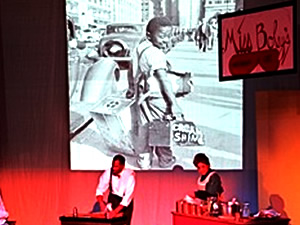 Arts Center on Saturday. The play is about the prosperous, African American Greenwood neighborhood of Tulsa, Oklahoma in 1921; and based on a historical book entitled Death in the Land of Promise.
Arts Center on Saturday. The play is about the prosperous, African American Greenwood neighborhood of Tulsa, Oklahoma in 1921; and based on a historical book entitled Death in the Land of Promise.
The play centers around an incident in an office building elevator which lead to a white attack on the Greenwood neighborhood of Tulsa, leaving somewhere between 30 and 300 dead [some of whom were shot in the back] and most homes in the neighborhood were burnt to the ground. After two days of house burning, gunfire and looting, the Governor of Oklahoma stepped in and declared martial law. But it was too late. The damage had already been done.
The play is a production of Shades of Truth Theatre Company, which produces and performs original works that tell largely untold tales of the African American experience. Click here for our report and slide show of Black Wall Street. In the photo above you can see the opening scene of Black Wall Street, where a young African American shoe shine is shown in an authentic vintage photo.
Black Wall Street At York College PAC
Coming To Grips With The Whole Of Our Nation's Past
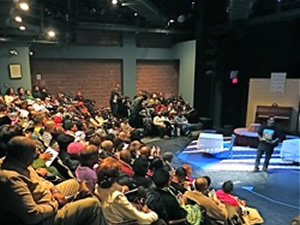 January 7, 2013 / Jamaica NY Neighborhood / Performing Arts in Queens / Queens Buzz. Continued. I arrived in time to find a good spot from which to watch the performance. And it was a good thing, as the one-night-only performance at the York Performing Arts Center in the Jamaica neighborhood of Queens, had been sold out.
January 7, 2013 / Jamaica NY Neighborhood / Performing Arts in Queens / Queens Buzz. Continued. I arrived in time to find a good spot from which to watch the performance. And it was a good thing, as the one-night-only performance at the York Performing Arts Center in the Jamaica neighborhood of Queens, had been sold out.
The woman sitting next to me told me that Black Wall Street had been performed on November 30th, 2012 at the Malcolm X and Dr. Betty Shabazz Memorial and Educational Center at 39-40 Broadway in the Harlem neighborhood of Manhattan. And that performance had also been sold out. In the photo to your left is the full house attending Black Wall Street at the York College Performing Arts Center in Jamaica.
Shades of Truth Theatre Company - Founder Michael Green
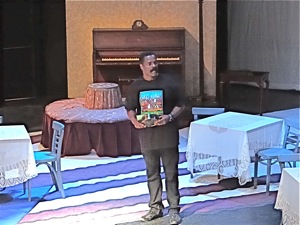 The lights dimmed and Michael Green, the Shades of Truth Theatre Founder and Black Wall Street Producer, took the stage and began telling us the story about the Negro slaves and Indian tribes who made their way west to Oklahoma in the early 1800’s. In the photo to your left is Michael Greene opening the play, Black Wall Street.
The lights dimmed and Michael Green, the Shades of Truth Theatre Founder and Black Wall Street Producer, took the stage and began telling us the story about the Negro slaves and Indian tribes who made their way west to Oklahoma in the early 1800’s. In the photo to your left is Michael Greene opening the play, Black Wall Street.
Michael gave us a short background summary about how this prosperous African Indian community came about, which was followed by a historical photo slide show on the stage which depicted African Indian American life in Greenwood Oklahoma around 1920. What follows is a more detailed account of the historical background for the play, followed by a description of the play itself.
Black Indians in American History: 1830 - 1840
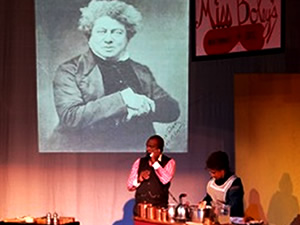 The story is about a group of Negro slaves, who had been sold to the [Cherokee and Choctaw] Indians who owned their own lands in Georgia, Alabama, Mississippi, Louisiana and Florida before the Indian Removal Act of 1830. Jackson signed the Indian Removal Act into law and gave the Indians ten years to leave their homes and lands to migrate west to Oklahoma. At the time Oklahoma was the distant frontier and something of a dry, barren wasteland. Eventually oil was found on these lands, providing wealth to those who owned them, including some of the African American Indians who lived in the Greenwood neighborhood of Oklahoma City.
The story is about a group of Negro slaves, who had been sold to the [Cherokee and Choctaw] Indians who owned their own lands in Georgia, Alabama, Mississippi, Louisiana and Florida before the Indian Removal Act of 1830. Jackson signed the Indian Removal Act into law and gave the Indians ten years to leave their homes and lands to migrate west to Oklahoma. At the time Oklahoma was the distant frontier and something of a dry, barren wasteland. Eventually oil was found on these lands, providing wealth to those who owned them, including some of the African American Indians who lived in the Greenwood neighborhood of Oklahoma City.
In the photo above is a scene from Black Wall Street, where an actual photo of an African American Indian circa the 1920's is shown in the background, while in the foreground is the central location for the play - a restaurant called Miss Boley's.
The Five Civilized Tribes - Washington, Jefferson & Franklin - Slaves
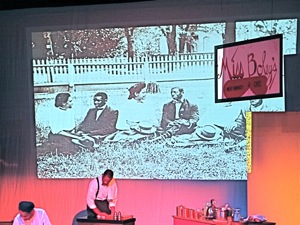 These two tribes, the Cherokee and Choctaw, were among the five ‘civilized tribes’ – which also included the Chickasaw, Creek and Seminole Indians. These five tribes were called the civilized tribes because George Washington believed the Indians were the white man’s equal, but that they had an inferior society.
These two tribes, the Cherokee and Choctaw, were among the five ‘civilized tribes’ – which also included the Chickasaw, Creek and Seminole Indians. These five tribes were called the civilized tribes because George Washington believed the Indians were the white man’s equal, but that they had an inferior society.
George Washington pursued policies designed to integrate the civilized tribes into white society. Jefferson pursued the same policies as Washington in working to teach the Indians the white man’s ways. It’s worth noting that Ben Franklin and George Washington freed their slaves in their Last Wills & Testaments, while Thomas Jefferson, who took one of his slaves as a mistress and sired one of her children, did not.
The photo above includes a vintage photo of African American life in Greenwood circa 1920 in the background, while in the foreground is Miss Boleys.
Andrew Jackson & the Indian Removal Act results in a 'Trail of Tears'
By the time Jackson came to office, the whites were concerned that the Indians might one day win back [in courts] all the lands that the whites had taken. Tensions flared and so Jackson saw the Indian Removal Act as a means to mitigate a growing problem. The act ended in what is today called the Trail of Tears where the Indian tribes made a migration to Oklahoma in 1838 – 1839, during which all suffered great hardships and many died.
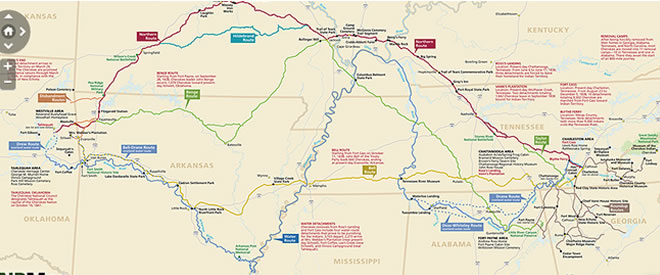
Several decades later in 1866, after slavery had been repealed, some of the Indians intermarried with some of their African-American slaves, and they carved out a life for themselves in the Oklahoma Territories.
The graphic above shows the 'Trail of Tears', from southeastern U.S. to the barren [but oil rich] wasteland called Oklahoma.
Based on book Death in a Promised Land by Scott Ellsworth
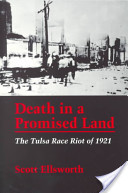 Michael Green informed me that the play was based on a book by Scott Ellsworth called Death in the Promised Land. Scott Ellsworth worked with historian John Hope Franklin, son of B.C. Franklin, to set the historical record straight by an Oklahoma state legislative act in 1996 [75th anniversary of the riot].
Michael Green informed me that the play was based on a book by Scott Ellsworth called Death in the Promised Land. Scott Ellsworth worked with historian John Hope Franklin, son of B.C. Franklin, to set the historical record straight by an Oklahoma state legislative act in 1996 [75th anniversary of the riot].
B.C. Franklin was the lawyer who successfully stopped Tulsa newspaper publisher John Brady from changing Tulsa districting laws so that all African Americans would have had to vacate the Greenwood neighborhood following the race riot - of which the play is all about. Based on the historical investigation, apparently Brady's newspaper helped incite the white rioters, and it seems that in the riot aftermath he also tried to be one of the riot beneficiaries. The bookcover of Death in a Promised Land, by Scott Ellsworth, is shown at left.
Oklahoma, Jim Crow Laws & Racism in America
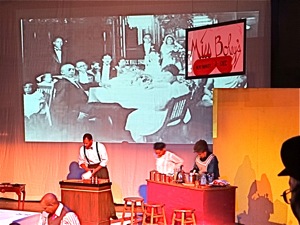 In 1907 Oklahoma became a state and quickly passed Jim Crow laws which essentially set the rules for segregation within the state. Thus the inhabitants of Greenwood, who had benefited from the discovery of oil on their lands, as well as government compensation for the lands they were forced to leave back east, lived and worked in their own communities where they lived lives that were on a par with whites who lived in other neighborhoods.
In 1907 Oklahoma became a state and quickly passed Jim Crow laws which essentially set the rules for segregation within the state. Thus the inhabitants of Greenwood, who had benefited from the discovery of oil on their lands, as well as government compensation for the lands they were forced to leave back east, lived and worked in their own communities where they lived lives that were on a par with whites who lived in other neighborhoods.
A high standard of living for African Americans was highly unusual for this time, particularly in southern states, as African Americans were prevented from holding government office and intermarrying with Caucasians by virtue of the Jim Crow laws. The photo above shows the high standard of living enjoyed by African Americans in the Greenwood neighborhood of Oklahoma City circa 1920.
Black Wall Street performance at the York Performing Arts Center
The play begins with the arrival of an African American reporter, Pritchard, at Miss 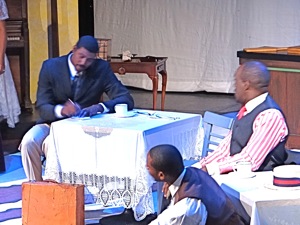 Boley’s restaurant in Greenwood. Pritchard is working a story on successful African American communities in the United States to better understand what makes these communities successful. Pritchard mentions that he would like to do for Greenwood, Oklahoma and other successful African American communities; what James Van Der Zee did for Harlem with his photography. And that there are some 58 other African American neighborhoods he had heard about that are enjoying some level of prosperity post WWI.
Boley’s restaurant in Greenwood. Pritchard is working a story on successful African American communities in the United States to better understand what makes these communities successful. Pritchard mentions that he would like to do for Greenwood, Oklahoma and other successful African American communities; what James Van Der Zee did for Harlem with his photography. And that there are some 58 other African American neighborhoods he had heard about that are enjoying some level of prosperity post WWI.
In the photo to your right Pritchard [at left - played by Tyrien Obahnjoko] is shown talking to Frank Boley [at right - played by Michael Leonard James] and the shoeshine boy Dick Rowland [center - played by Deron B. Campbell].
James Van Der Zee - Harlem Renaissance Photographer
It’s worth adding that James Van Der Zee’s photography in the early decades of the 1900’s portrayed African American life in Harlem as very similar to White American life, 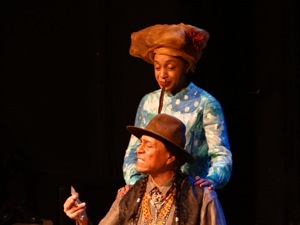 while also exploring African American culture including music and the arts. It was one of the first times that African American life was portrayed in a positive manner.
while also exploring African American culture including music and the arts. It was one of the first times that African American life was portrayed in a positive manner.
Through Pritchard’s conversations in Miss Boley’s we begin to get a flavor of the lifestyle and some of the issues which presage the impending events. Uncle Rain is an Indian and a bit the wise man, as he has lived long and has had many dealings with the white man. Given his experience he understands that money is generally the root of the cause. In a conversational style, he tells Pritchard, the reporter, some of the history outlined above. In the photo above, Uncle Rain [seated - played by Keith Darnes] is dispensing some ancient Indian wisdom, while Molly Boley [played by Ethel Calhoun] looks over him.
Dr. Jackson is one of the regular customers at Miss Boley’s. He’s an educated doctor who came to Greenwood to start a practice, because it was difficult to practice in white communities. We learn through the Boley’s about the flourishing business community in Greenwood and we can see by the way the folks dress and their comfortable surroundings, that all is well in the neighborhood of Greenwood, Oklahoma.
Early 20th Century Paris - A Multi-cultural City
Princess, the young daughter of the Boleys, has traveled to Paris. She informs us that  race and skin color do not seem to be an issue in Paris. We hear she’s planning to get married sometime in the very near future and the wedding plans are in the making. Princess is also a longtime friend of Dick Rowland, a handsome, enterprising and fun-loving shoeshine boy who works outside a fancy office building in Tulsa.
race and skin color do not seem to be an issue in Paris. We hear she’s planning to get married sometime in the very near future and the wedding plans are in the making. Princess is also a longtime friend of Dick Rowland, a handsome, enterprising and fun-loving shoeshine boy who works outside a fancy office building in Tulsa.
Della, a maid at one of the fancier white homes in Tulsa, arrives around lunchtime. She’s on her lunch break and participates in the wedding conversation while giving us snatches of her life as a maid in one of the white homes. It is through her eyes that we see a bit of their point of view. Della [played by Alua Monk Addo] is shown center in the photo at left, with Pritchard on the right and Bill Boley [played by Tomike Ogugua] cleaning a glass on the left.
Negro Veterans of WWI - Come Home to an Unchanged World
Bill Boley is a butcher by trade and a veteran of the WWI [Bill Boley in a soliloquy in the photo below]. He tells us what it was like fighting the war, referencing the historical Harlem Hellfighters of the 369th regiment in 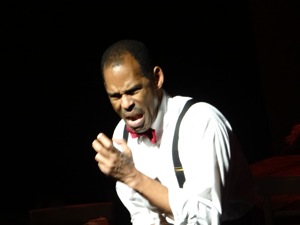 WWI. The Harlem Hellfighters fought in many battles, showed outstanding courage and bravery, and were awarded medals for such courage by both the United States and French governments. But the African American WWI veterans were disappointed when they returned home, as they were once again relegated to being second class citizens.
WWI. The Harlem Hellfighters fought in many battles, showed outstanding courage and bravery, and were awarded medals for such courage by both the United States and French governments. But the African American WWI veterans were disappointed when they returned home, as they were once again relegated to being second class citizens.
Another WWI veteran is also a regular client of Miss Boley’s and a friend of Bill’s. They commiserate with each other about life for African Americans outside of Greenwood. They make reference to Whites attacking African American neighborhoods in 1919 in what is called the Red Summer Riots. The Red Summer Riots happened in many towns throughout the southern states, as well as in some of the larger commercial cities in the north like Chicago and New York. The tensions had to do with a rising standard of living earned by African Americans during wartime [they were recruited for northern factories] as well as African Americans taking a more assertive stand with regard to exercising their rights in the wake of returning from war.
WWI African American Veterans Come Home - Worldly, Changed Men
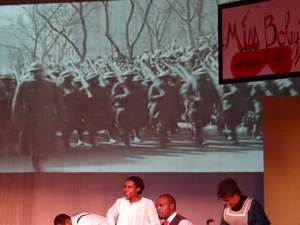 After the war men like Bill Boley and Peg Leg have come around to the belief that they’ve got to fight for their rights or someone will take them away. Since they risked their lives once before, for the government, they’re not afraid to risk their lives for things that are a bit closer to home. In the photo on the left is a vintage photo of African Americans marching victoriously through Harlem following a successful stint fighting in WWI.
After the war men like Bill Boley and Peg Leg have come around to the belief that they’ve got to fight for their rights or someone will take them away. Since they risked their lives once before, for the government, they’re not afraid to risk their lives for things that are a bit closer to home. In the photo on the left is a vintage photo of African Americans marching victoriously through Harlem following a successful stint fighting in WWI.
Racial Incidents "Usually start with a Woman's Scream"
The first half of the play ends with Dick Rowland returning home saying he’s been accused of attacking a young female elevator operator in the elevator in the office building in front of which he worked. His account is that he slipped and his hands ‘touched’ her. While interracial relationships were taboo at the time, historical accounts of the incident ponder the question of whether the elevator girl and the shoeshine boy had a prior relationship. There isn’t any historical record of any accusation / statement by the young woman.
Shades of Truth Theatre Company of Harlem & Founder Michael Green
At intermission I met with Michael Green to learn a bit more about Shades of Truth Theatre Company. Shades of Truth Theatre is a Harlem based theater company focused 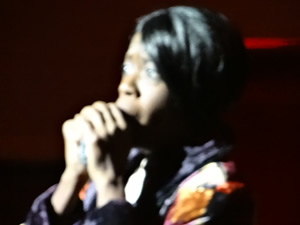 on telling the stories of the African American experience. Stories which haven’t seen much light of day prior to the 1964 Civil Rights Act, and only now are coming into the national consciousness. The Shades of Truth Theatre Company was formed in 2005 and is located in Harlem.
on telling the stories of the African American experience. Stories which haven’t seen much light of day prior to the 1964 Civil Rights Act, and only now are coming into the national consciousness. The Shades of Truth Theatre Company was formed in 2005 and is located in Harlem.
The Shades of Truth Theatre Company has performed many of its prior works at the York College Performing Arts Center in Jamaica. All performances are historically based, but at times some measure of poetic license is taken. Prior performances at the York College Performing Arts Center include: The Meeting: A Conversation between Malcolm X and Martin Luther King Jr, The Lynching of Emmett Till and there’s a forthcoming performance in April of 2013 of Camp Logan at the York College Performing Arts Center.
Greenwood Oklahoma, Black Wall Street & the Tulsa Riots
The second act begins with some reassurance by the sheriff that the boy must be held 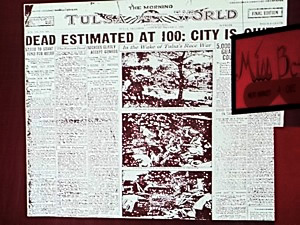 for questioning, and perhaps for his own safety. The sheriff informs them that there won’t be a lynching, as had happened within the past year or two under the auspices of another sheriff. To reinforce the sheriff’s words, policemen are stationed atop the jailhouse where Dick Rowland is being held. But a large white crowd has formed and is calling for a hanging.
for questioning, and perhaps for his own safety. The sheriff informs them that there won’t be a lynching, as had happened within the past year or two under the auspices of another sheriff. To reinforce the sheriff’s words, policemen are stationed atop the jailhouse where Dick Rowland is being held. But a large white crowd has formed and is calling for a hanging.
The folks at Miss Boley’s debate what they should do. Peg Leg advocates for going down to the jailhouse to help the sheriff, but Frank Boley, the businessman and father of Princess, thinks that might only make the situation more combustible. Peg Leg gets Bill Boley, Frank’s brother and a former veteran, to come to his way of thinking and they begin arming themselves. The women head off to church to pray.
The Rest of the Story - African American History Brought To Life
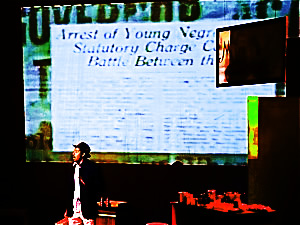 Throughout the discussions, references to past events is brought to the fore, as the play unearthed events and people of whom I’d either nothing at all or very little. That appears to be the intention of the Shades of Truth Theatre Company and they did it well.
Throughout the discussions, references to past events is brought to the fore, as the play unearthed events and people of whom I’d either nothing at all or very little. That appears to be the intention of the Shades of Truth Theatre Company and they did it well.
The exact sequence of what happens next is a bit unclear, but shooting starts between whites and blacks. The African Americans are heavily outnumbered and hundreds are injured. There are somewhere between tens and hundreds of casualties – most of whom are African American, and the Ku Klux Klan plays a significant role in the melee. Even a plane is used to drop dynamite on the homes in the neighborhood. By Tuesday morning [this began on Memorial Day] the town is afire and eventually martial law is declared.
Epilogue - Greenwood Oklahoma Neighborhood Land Grab by Whites
Promises are made to rebuild Greenwood, but they never did. And as mentioned above, 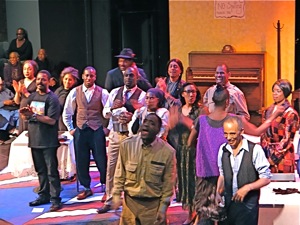 some of the white business people try to change the districting laws so they can grab the land, but the law is thrown out by the courts.
some of the white business people try to change the districting laws so they can grab the land, but the law is thrown out by the courts.
It was an interesting tale and well told. The use of the reporter Pritchard as a character and Miss Boley’s restaurant as a venue was a nice way to present an historical play. And the acting, the costumes and the props, including the slide show, were all very well done. In the photo to your right is the cast and crew for the play of Black Wall Street at the York College Performing Arts Center in Jamaica.
The play will be performed in at Long Island University in Brooklyn on February 8th, 9th and 10th. For discounted tickets use the passcode FriTruth on Friday [save $15] and SatTruth on Saturday [save $20].
And Camp Logan will appear at the York College Performing Arts Center on April 6th.
Black Wall Street - Characters & Cast
The following are the characters and the names of the cast members who played them. Please note that in several cases there may be more than one actor or actress per character, as there have been substitutions to accommodate family and health situations.
- Della the Maid - Afua Monk Addo
- Molly Boley - Ethel Calhoun
- Dr. A.C. Jackson - Nelson Chimilio
- Dick Rowland the Shoeshine - Deron B Campbell
- Uncle Rain Indian Chief - Keith Darnes
- Princess Boley the Daughter - Khalimah Gaston
- Frank Boley the Father - Michael Leonard James
- Maria the Spanish Helper - Adrienne Lyric
- Grandma Boley - Rev Rhonda Mcleannur / Akanke
- Pritchard the Reporter - Tyrien Obahnjoko
- Bill Boley the Butcher, Vet & Brother - Tomike Ogugua
- Dr. A.C. Jackson Byron Saunders
- Grandma Boley - Niambi Steele
- Peg Leg the Vet - Rahsan Taylor
The play was produced by Michael Greene, Founder of the Shades of Truth Theatre Company, and directed by Aixa Kendrick, Douglas Rory Milliron was the Fight Choreographer and Naza Usher the Stage Manager. The production was hosted at the York College Performing Arts Center in Jamaica.
Photos of the Rent at the York College Performing Arts Center
Click here to view photos of Black Wall Street performed by the Shades of Truth Theatre at the York College Performing Arts Center in Jamaica Queens NY, or you can view the photos below at your own pace by clicking on the arrows.
$element(ophoto,photo_slideshow,223,660,,5.00,fade)$
Jamaica NY Related Info
Click this link for promotions, discounts and coupons in Jamaica and Queens.
Click this link to go to the Jamaica Neighborhood News / Jamaica Restaurants Guide & Map / Jamaica Business Directory / Jamaica Shopping Center and Map.
Site Search Tips. 1) For best results, when typing in more than one word, use quotation marks - eg "Astoria Park". 2) Also try either singular or plural words when searching for a specific item such as "gym" or "gyms".
$element(bwcore,insert_search,N)$
Click this link to search for something in our Queens Business Directory.
Click the log in link below to create an ID and post an opinion.
Or send this story to a friend by filling in the appropriate box below.















